
Today I'm giving you all the handy tips on how reuse dead leaves.
Because red autumn leaves are very pretty, but once they have fallen on the lawn, something has to be done with them.
If you usually put them in garden paper bags to get rid of them, stop that immediately.
There is much better to do! The leaves are actually a real treasure for the garden.
Mulch, natural fertilizer, animal shelters... Above all, don't throw them away and reuse them!
Want to know how?
Here are 14 practical tips for reusing dead leaves at home. Watch:


Picking up dead leaves in your garden is important for several reasons.
Firstly, because the dead leaves that have fallen to the groundchop the lawn and can cause it to die!
The leaves, stuck together due to humidity, block sunlight, air and water.
Your lawn no longer breathes and you see mushrooms, moss and all kinds of parasites appear.
Next, be aware that some leaves can transmit diseases to other plants.
Horse chestnut leaf miner, apple monilia, peach leaf curl...
If you see suspicious spots or notice the presence of these diseases, isolate these leaves well.
Something else; if you have pets like me, dead leaves can make them sick.
Here, take my dog for example; he loves to roll in the heaps of dead leaves.
Well, be careful, because it's full of ticks or fleas!
Finally, it would be a real shame to leave dead leaves on the ground without doing anything about them.
The leaves are indeed a organic matter of choice for your soil.
So let's reuse them. They are free!

I advise you to frequently pick up dead leaves to avoid all the problems mentioned above.
Try to pick them up as soon as possible after they fall so they don't rot.
The best for me is to use the lawn rake.
Its teeth and large head bring up dead leaves very easily, all without destroying your lawn!
If you want to aerate the soil at the same time, use a duster lawn rake.
This tool allows, in addition to picking up leaves, scratching the ground and removing moss.
You can also use a mower as a radical solution since it cuts through the piles of dead leaves without any problem.
Many also use blowers. For my part, I'm not a big fan of this machine.
It's heavy, makes noise, pollutes and dislodges a whole bunch of little insects that didn't ask for anything.
Finally, it's up to you to see according to your preferences...
Ah yes; last thing. Avoid burning the leaves in the open air.
It is bad for the environment and for the health of people exposed to the smoke.

Be aware that some dead leaves can be dangerous for the rest of your plantations.
Here, take walnut leaves for example.
Well, they contain a toxic substance that can affect the growth of nearby plants.
Did you know that? No?
So be careful before mixing these leaves with other plants.
Ditto for leaves that are attacked by mildew or certain fungal diseases.
In contact with healthy plants, these diseases spread rapidly and destroy the ecosystem.
In general, if you see spots on the leaves or if the tree is diseased, throw them in the trash.
I really insist on this point.
Otherwise, for the rest of the leaves, it's just happiness. They are a real treasure for the garden.
Look.
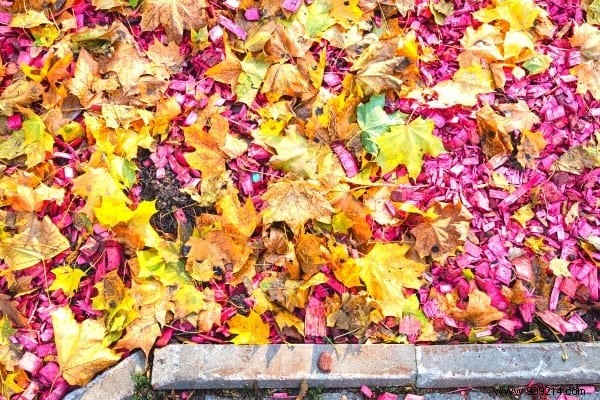
When winter arrives, some plants need to be protected from the cold.
This is where leaf litter comes in.
Mulching the areas where the fragile plants are protects them from the cold.
Place your dead leaves at the foot of the plants at least 10 to 20 cm thick.
Preferably, scatter shredded leaves, as this allows air and water to circulate better.
If you are in windy corners, you can add a nylon net fixed to the ground with pegs.
That way it doesn't fly away.
Once spread for the first time, water them down to help keep them in place.
In addition to offering protection to your plants, the decomposing leaves also fertilize your soils.
Dead leaves provide your plants with potash, nitrogen, calcium, sulfur and so on...
So, you might as well combine business with pleasure.

During the winter season, less vegetation grows and the ground becomes bare.
Weeds then appear and can invade this entire surface.
To avoid this phenomenon, cover bare and unfrozen areas with dead leaves without packing them down.
Put some at the foot of the massifs and on the portions of cultivation without vegetation.
This little trick from behind the bundles helps protect against weed invasions.
Along the same lines, you can also use this trick to get rid of weeds.
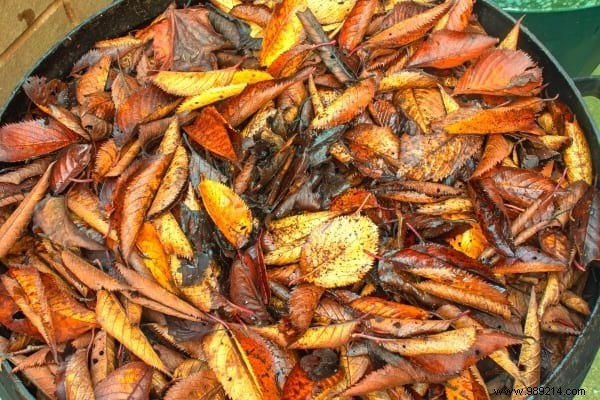
To enrich your compost, nothing better than adding a few dead leaves.
This creates a well-balanced substance to feed the garden.
Indeed, good compost must be made up of green organic matter and brown, dry organic matter.
Fresh grass clippings are good green materials.
Fallen leaves are a perfect brown material.
Mix the crushed leaves loosely with the rest of the compost (bannage, grass clippings).
Close the compost bin tightly with a lid to mature and retain all the benefits of fermentation.

Same as for the mulching of flowerbeds, covering the surfaces of a vegetable garden has 2 advantages.
Protect the vegetable garden from winter while nourishing the soil.
Put a layer of 10 to 20 cm of dead leaves between the rows of vegetables and on the free plots.
Avoid packing the leaves together and put a little soil to prevent them from blowing away.
As the leaves decompose, they provide nutrients to the surface layer of the earth.
Earthworms continue the decomposition process and make the soil more flexible.
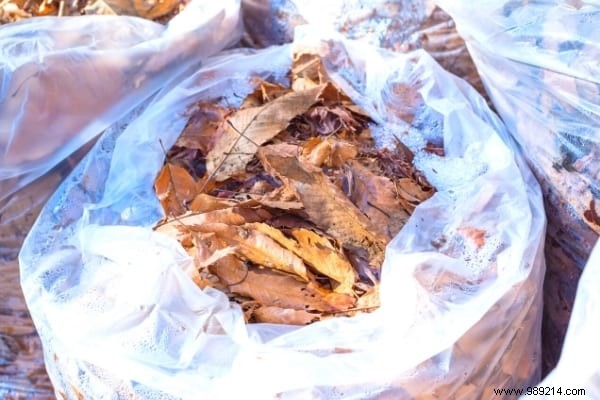
Are you interested in having an excellent quality potting soil completely free?
Well you just have to use your dead leaves in this case!
Indeed, the decomposition of dead leaves ends up giving you a very good soil.
How do we do it? Nothing simpler.
Put your dry leaves in a garbage bag type bag and close without tightening too much.
Hole the bag in a few places over the entire surface and watered 1 time per month.
After about a year, the leaves turn into excellent soil.
No need to go buy it anymore; you make your own for free at home.

When the temperatures start to drop, your young plants may not like it.
It is therefore better to protect them from the cold so as not to kill them.
To achieve this, scatter dead leaves at the base of your plantations by covering the soil.
Ventilate well to release moisture and you're done. Your plants are protected from the cold.
And if your plants are in pots, I also have the solution.
Wrap the plant in wire and place the dead leaves inside the fence all around the plant.
In the spring, remove the fence, rake the leaves and use them for compost.
Also, if you have vegetables to store over the winter, dead leaves can be used.
Stack your crates, covering each of them with dry dead leaves.
This creates an insulator that is a perfect replacement for the sawdust or newspaper traditionally used.

Decidedly, dead leaves save us enormous savings in gardening.
Here, take the fertilizer. No need to buy expensive off-the-shelf products.
Do like me instead.
Take your dead leaves and store them in a plastic container for 18 to 24 months.
Their decomposition generates a very qualitative fertilizer and I repeat, totally free.

During the winter, small animals and batrachians like to nest in the piles of leaves.
Not only do they find food there (insects, earthworms), but they also feel good there.
Do not hesitate to scatter a few piles of dead leaves in quiet places in your garden.
By doing this, you create a real little ecosystem.

2 years ago, frost wreaked havoc in my garden.
My gunnera, chrysanthemums and my tulips have been completely decimated!
But they won't take me twice, because I now know how not to be fooled.
I surround my plants with a trellis and I add in the empty parts a large pile of dead leaves.
My plants are thus protected from frost during the winter.
I just have to remove the leaves as soon as the good weather arrives.
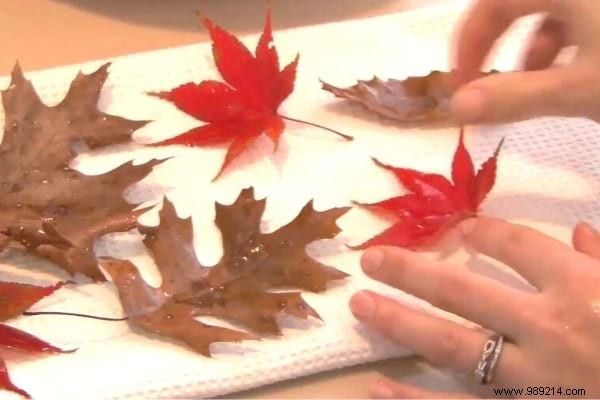
The last time I was at a friend's house and I was very pleasantly surprised by an original decoration idea.
He recovers clean and relatively intact dead leaves to make decorative objects.
He puts them in herbariums, frames or wedges them under a table glass.
Frankly I was amazed by the rendering.
He even colored some of them. It was really nice to see.
And when I asked him how he kept them, he replied that he had a particular technique.
He irons the sheets by putting them between 2 kraft papers.
Kraft paper wraps the sheets so they are protected.
All you have to do is cut them out and use them for decoration.

So yes, I told you that leaves can choke your soil.
But they can also feed it if you do it right; I'll tell you how to do it.
Simply run the mower, preferably with mulching function, over the leaves.
If you didn't know, the mulching function allows you to cut grass and leaves into very small pieces.
It avoids leaving a thick layer of leaves on the lawn, which could effectively smother it.
If your mower is not equipped with the mulching function, you can do otherwise.
Set your mower to its highest cutting height and mow on it.
This cuts the leaves into small pieces and allows them to decompose in the lawn.
These 2 techniques save you time and energy, because you no longer have to pick up the leaves.
Your grass stays healthy all winter long and into spring.
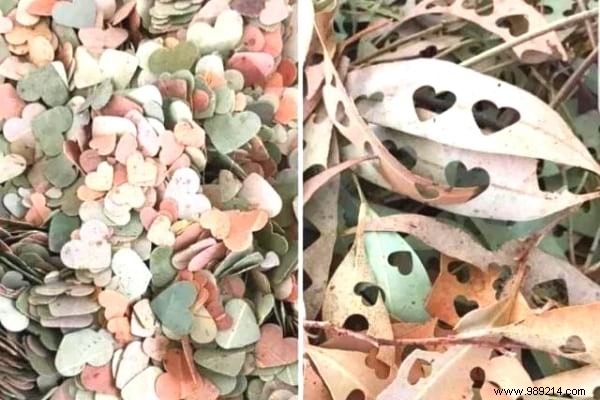
For your little parties and birthdays, are you used to using paper confetti like everyone else?
Well, be sure to read on, because I'm showing you an alternative, mind-blowing trick.
Take some dead leaves and simply make small holes with your punch.
Result:you get an almost unlimited number of confetti with beautiful colors and above all biodegradable!
Awesome right?!
You can even create other shapes (heart...).
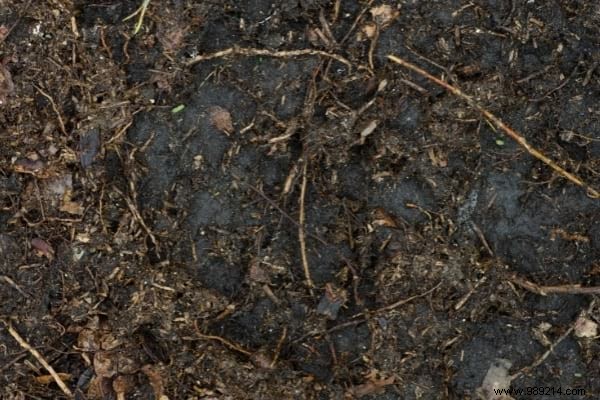
Another simple way to use dead leaves is to let them turn into humus.
In a secluded spot in the garden, pile them up and wet them.
Then trample the pile and add a few shovelfuls of good soil.
Repeat this each time you add leaves during the fall.
In spring, the leaves are broken down and are transformed into good nourishing humus.
All you have to do is spread it at the foot of the shrubs or in the garden.
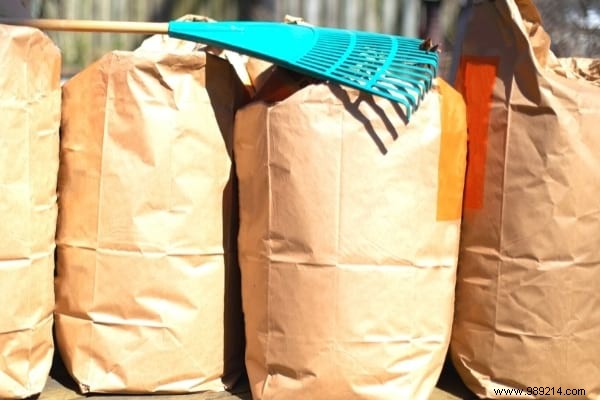
Is it always very cold in your garage or in your basement during the winter?
I have a solution for you, and it costs absolutely nothing in heating!
Collect as many leaves as possible, dry them and put them in bags.
Fill the bags well to the maximum and store them in the cold areas of the house or garden sheds.
These leaf bags act as insulation helping to keep the space warm during the winter.